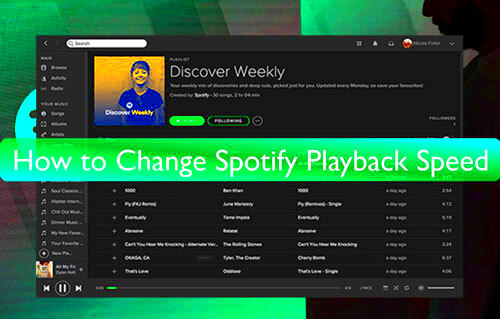Have you ever thought that a song is so lovely that it zooms by too quickly for you to really savor all its subtleties? I can relate, especially when it comes to some timeless tunes that seem to breeze past their rich intricacies.
Spotify has made it super convenient to tailor your listening experience and one feature that often flies under the radar is the option to slow down songs. Whether you're a musician dissecting a track or just someone wanting to enjoy a song at a more leisurely tempo hitting the brakes on the music can provide a fresh outlook. Let's explore how you can slow down songs on
Spotify and why you might want to give it a shot.
Understanding the Basics of Spotify's Playback Speed

Here’s a quick breakdown:
- Normal Speed (1x): This is the default speed where the song plays as intended by the artist.
- Slow Down: This can be achieved using third-party apps or tools that alter the playback speed without affecting the pitch of the music.
A lot of people don’t know about this feature as it’s not really highlighted in the
Spotify app. But if you’re curious to check it out there are tools out there that can help you with it. I found these tools to be incredibly helpful when I was trying to analyze pieces of music for a class I was teaching.
Why Decelerate Songs? Benefits and Use Cases
Slowing down songs may seem like a unique hobby but it can actually be quite beneficial in different situations. Here are some reasons you might consider giving it a shot.
- Musical Analysis: If you’re learning to play an instrument or trying to understand a song’s structure, slowing it down helps you catch every note and nuance. I remember painstakingly slowing down a difficult guitar solo to finally get it right.
- Relaxation: Some people find that slower tempos make songs more soothing and enjoyable. After a long day, unwinding with your favorite tracks at a slower pace can be quite therapeutic.
- Language Learning: If you’re learning a new language, slowing down the music can help you catch and understand the lyrics more easily. It’s a trick I used when trying to improve my Spanish through Latin music.
- Accessibility: For those with hearing impairments or sensory processing disorders, slowing down music can make it more accessible and less overwhelming.
These scenarios provide unique insights into the benefits of slowing down songs to enrich your listening experience. Whether you’re studying music for learning or seeking a laid back rendition of your beloved tracks this is an option that deserves consideration.
Step-by-Step Guide to Using Spotify's Built-In Features
Spotify is an awesome platform for music enthusiasts but its standard features may not always meet all your requirements. Although
Spotify doesn’t offer a way to directly change the speed of song playback there are some clever tricks and alternatives that can assist you in achieving a tempo. Here’s a guide on how to explore these possibilities:If you want to slow down how fast things are said in podcasts or audiobooks on
Spotify you can tweak the playback speed. Here’s how to do it.
- Open the podcast or audiobook.
- Tap on the Playback Speed option (usually represented by a speedometer icon).
- Select your desired speed (0.5x, 0.75x, etc.).
To slow down music tracks on
Spotify you’ll have to use tools or apps since the regular music player doesn’t offer a feature for that. Nevertheless you can curate playlists to sort your favorite songs that you may want to slow down later through alternative methods.I recall attempting to take my time with a difficult instrumental composition I was studying. Annoyed by the restrictions of Spotify I discovered that arranging my songs into playlists streamlined the process when I utilized external applications to accomplish the desired outcome. This was a simple solution that had an impact on my music rehearsal schedule.
Exploring Third-Party Tools for Slowing Down Music
When Spotify's built in functionalities don't quite meet your needs external applications can step in to save the day. These apps prove to be invaluable when it comes to reducing the tempo of songs while keeping the original tone intact. Let me give you an overview of a few well known choices.
- Audacity: A free, open-source audio editor that allows you to adjust the speed of music files. You can import your Spotify songs (using Spotify’s offline feature) and then use Audacity to slow them down.
- Capo: This tool is tailored for musicians. It allows you to slow down music, change pitch, and loop sections. Ideal for practice sessions.
- Transcribe!: Another useful tool for musicians that can slow down music and even help transcribe it into sheet music.
I found my time using these tools to be really eye opening. Slowing down a tricky violin piece in Audacity was a game changer for my practice routines. Its incredible how these resources can deepen your appreciation and love for music.
How to Download Images and Visuals for Your Decelerated Tracks
When it comes to tracks slowing down the right visuals can really elevate the vibe whether you're showcasing your music rehearsals or producing content. Here's a guide on how to find and incorporate images for your decelerated tunes.1.
Choosing the Perfect Visuals: Platforms such as [HDStockImages](https://hdstockimages.com) provide a collection of top notch images for your use. Seek out pictures that align with the atmosphere of your music be it soothing, intense or something completely different.
- Visit the image library.
- Use search terms related to your music's theme.
- Choose images that resonate with the decelerated tracks you’re working with.
2.
Acquiring and Utilizing Pictures: After discovering the ideal pictures save them in quality. Be sure to review the licensing agreements to confirm that you are using the images correctly.Throughout my path as a creator using visuals has brought a unique flair to my musical endeavors. For example combining a tranquil picture with a mellow instrumental piece evoked a soothing ambiance that resonated well with my listeners.With these suggestions you’re ready to elevate your musical journey whether its delving into songs savoring them at a leisurely tempo or spreading the joy of music with others. Enjoy the melodies and let your creativity flow!
Tips for Enhancing Your Music Listening Experience
Enhancing the enjoyment of music goes beyond simply playing it at a pace. It involves setting the mood and utilizing the appropriate resources. Here are a few suggestions that have significantly impacted my musical journey and could benefit you as well.
- Create a Cozy Listening Space: Whether you’re relaxing after a long day or deep in study, having a dedicated, comfortable space can enhance your listening experience. I’ve found that setting up a cozy corner with good headphones and some soft lighting makes a world of difference.
- Use Quality Headphones: Invest in a pair of good-quality headphones or speakers. The richer the sound, the better your overall experience. I remember switching to high-fidelity headphones and it was like hearing my favorite songs for the first time.
- Explore Different Genres and Artists: Slowing down familiar tracks can be an eye-opener, but why not expand your horizons while you’re at it? Discovering new genres or artists at a slower pace can reveal nuances you might miss otherwise.
- Experiment with Visuals: Pairing music with the right visuals, such as album art or background images, can deepen the experience. This personal touch can make listening sessions feel more immersive and enjoyable.
- Adjust Your Environment: Background noise can interfere with your listening experience. Try to minimize distractions or use noise-cancelling headphones to focus solely on the music.
When I began integrating these habits into my routine they transformed my laid back music moments into something extraordinary. Its really about discovering what suits you and enhancing your musical experience to make it more pleasurable.
Troubleshooting Common Issues with Slow Playback
Slowing down songs can be a great way to savor the music but it doesn't always go off without a hitch. Here are a few challenges you may come across along with some suggestions on how to overcome them.
- Audio Distortion: Sometimes, slowing down music can lead to distortion. This can often be fixed by using high-quality playback software or tools. I’ve found that tools like Audacity help maintain sound clarity even at slower speeds.
- Inconsistent Speed Changes: If you’re using third-party tools and notice inconsistent speed changes, make sure you’re using a reliable and updated application. Check for updates or consider trying a different tool if problems persist.
- Sync Issues: For those using slowed-down tracks in videos or presentations, syncing problems might occur. Ensure that your audio editing tool is set to match the video’s frame rate for smooth integration.
- Playback Lag: Sometimes, slower playback can cause lag. This can be due to your device’s processing power. Closing other applications or restarting your device might help alleviate this issue.
I recall grappling with challenges when I began exploring playback speed for my personal projects. Investing effort in troubleshooting and discovering the appropriate resources had an impact and I trust that these suggestions will assist in smoothing over any obstacles you may come across.
FAQ about Decelerating Songs and Using Spotify
As you delve into the realm of music played at a pace, you may find yourself pondering certain queries. To assist in clearing up any uncertainties here are some commonly asked questions.
Can I slow down songs directly on Spotify?
- Unfortunately, Spotify does not offer a built-in feature for slowing down songs in its music player. You’ll need to use third-party tools to achieve this.
What are some good third-party tools for slowing down music?
- Some popular options include Audacity, Capo, and Transcribe!. These tools are effective for adjusting playback speed without altering pitch.
How do I use slowed-down tracks in my own projects?
- After slowing down your tracks using third-party tools, you can export them and use them in video or audio projects. Ensure your editing software is compatible with the new file formats.
Are there any tips for getting the best results with slowed-down music?
- Use high-quality audio files and reliable playback tools to maintain sound quality. Experiment with different speeds to find what works best for your needs.
My responses are based on my personal journey and my exploration of the music industry. I aim to offer insights that enhance your understanding and enrich your enjoyment of music.
Conclusion: Enjoying a New Dimension of Music on Spotify
Slowing down music unveils a fresh realm of auditory experiences enabling you to savor every subtlety and nuance within your beloved songs. Whether you’re delving into intricate compositions unwinding with calming melodies or crafting content these methods and resources can enrich your musical adventure. Seize the chance to approach music from a perspective and allow the leisurely pace to uncover, new dimensions of pleasure.
 Here’s a quick breakdown:
Here’s a quick breakdown:
 admin
admin








